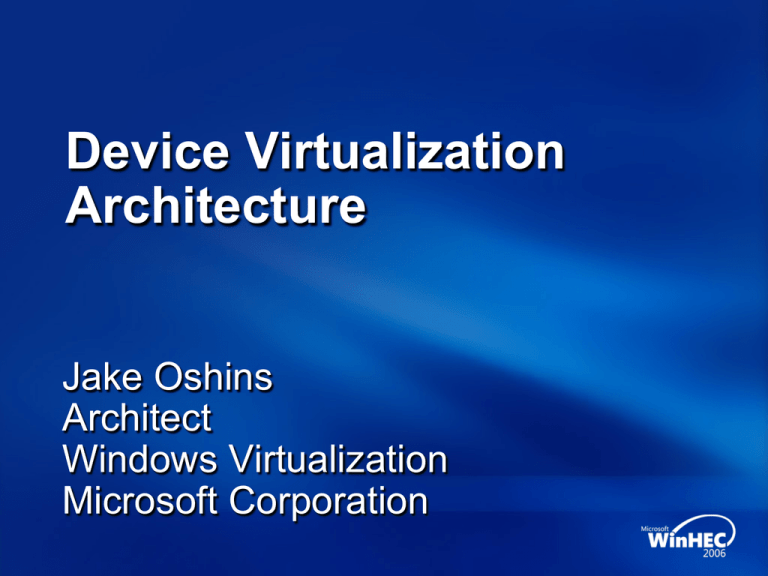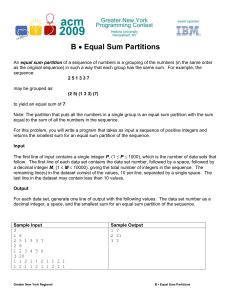
Device Virtualization
Architecture
Jake Oshins
Architect
Windows Virtualization
Microsoft Corporation
Goals
!
Participants will leave with an
understanding of
!
!
!
How Microsoft intends to enable efficient I/
O virtualization
How others’ I/O solutions interact with
Microsoft’s virtualization systems
Which I/O virtualization strategies will
be available with Windows Server
virtualization and which must wait
Agenda
!
!
!
General strategies for I/O virtualization
Technical overview of
Virtual Device Framework
Technical overview of VMBus
Device Emulation
!
!
Virtual machine “sees” real hardware devices
Each access to the “device” involves an intercept, sent to
the parent virtual machine
!
!
!
Compatibility with existing software can be perfect
Microsoft provides emulations
!
!
!
Performance is sub-optimal
The hardware that is emulated is from ~1997, providing
in-box compatibility with old OSes
Requires a “monitor” partition that contains software for
emulating the devices
Physical devices can be shared among
multiple guests
I/O Enlightenment
!
!
Uses abstract protocols to describe I/O
Useful protocols already exist
!
!
!
!
!
!
!
!
SCSI, iSCSI
RNDIS
RDP
New device stack implementations in the
secondary guests can be written that use
these abstract protocols
Protocol servers exist in a primary guest
(parent), which is the partition that controls
the physical devices
Multiple secondary guests can share the services
of a single hardware device
Doesn’t require an emulator
Doesn’t require a monitor partition
Device Assignment
!
Guest OSes control their devices directly
!
!
!
!
!
Parent OS gives up control of these devices
Ownership of a device is exclusive
Performance can match that of a
non-virtualized machine
Interdependence of partitions can
be minimized
Strong isolation of partitions can
be achieved
Windows Virtualization
Will Provide
!
Device emulation
Provides migration path for Microsoft Virtual
Server users
! ~1997 era virtual motherboard
! Good for compatibility with old OSes
!
!
I/O enlightenment
!
!
!
!
Storage
Networking
Video
USB
Agenda
!
!
!
General strategies for I/O virtualization
Overview of
Virtual Device Framework
Technical overview of VMBus
Virtualization I/O Definitions
!
Virtual Device (VDev)
!
!
A software module that provides a point of configuration and control over
an I/O path for a partition
Virtualization Service Provider (VSP)
!
A server component (in a parent or other partition) that handles
I/O requests
! Can pass I/O requests on to native services like a file system
! Can pass I/O requests directly to physical devices
! Can be in either kernel- or user-mode
!
Virtualization Service Consumer (VSC)
!
A client component (in a child partition) which serves as the bottom of an I/
O stack within that partition
! Sends requests to a VSP
!
VMBus
!
A system for sending requests and data between virtual machines
Virtual Devices (VDevs)
!
Come in two varieties
!
Core: Device emulators
!
!
Plug-in: Enlightened I/O
!
!
!
Written by Microsoft and industry
Management is through WMI
Packaged as COM objects
!
!
Written by Microsoft
Run within the VM Worker Process
Often work in conjunction with a VSP
VDev Environment
Virtual Machine Worker Process
Create Timer
Save
Powering Down
Activation
Repositories
COM
COM
Core
VDevs
Core
VDevs
Core
Vdevs
- Devices
Emulated
&&Hybrid
EmulatedDevices
Devices
Hybrid
Emulated Devices Devices
State
Changes
Virtual Motherboard
State
Core Only
Configuration
Saving
State
Memory and
Port-Mapped IO
Current Time
Powering Up
To VSP
Plug-In
Plug-In
Plug-In
VDevs
VDevs
VDevs
To VSP
IRQ Generation
Active
Changes
Guest Memory
Timers
State Machine
Changes
Virtual
Hardware
Virtualization Service
Providers (VSPs)
!
!
Communicate with a VDev for
configuration and state management
Can exist in user- or kernel-mode
!
!
!
!
COM object
Service
Driver
Use VMBus to communicate
with a VSC in the child partition
Example VSP/VSC Design
Parent
Child
Viridian Virtualization Stack
Worker Process
User Mode
User Mode
Kernel Mode
Kernel Mode
File System
Volume
File System
Parition
Volume
Disk
Parition
Image
Parser
Disk
Virtual
Storage
Server
(VSP)
FastPath filter
iSCSIprt
VM SRBs
Storport
Miniport
Virtual
Storage
Miniport
(VSC)
VM SRBs
StorPort
VMBUS
Hardware
Agenda
!
!
!
General strategies for I/O virtualization
Technical overview of
Virtual Device Framework
Technical overview of VMBus
VMBus – What Is It?
!
A protocol for transferring data through a ring buffer
!
!
!
!
!
!
!
!
!
A means of mapping a ring buffer into multiple partitions
A definition for the format of the ring buffer
A means of signaling that a ring buffer has gone non-empty
A protocol for offering/discovering services
A protocol for managing guest physical addresses
A protocol for enumerating WDM device objects
that represent a data channel
A bus driver which implements all of those protocols
A data transfer library which can be linked into
a user-mode service or application
A data transfer library which can be linked into
a kernel-mode driver
VMBus Definitions
!
Endpoint
!
!
Channel
!
!
!
A module that reads or writes data through VMBus
Two endpoints – one server, one client
Two ring buffers
Transfer Page
Pre-allocated page of memory that is mapped
into both endpoints’ partitions
! Not part of a ring buffer
! Used as a target for DMA or for other operations that
may take a “long” time to complete
!
VMBus Definitions
!
Guest Physical Address Descriptor
List (GPADL)
!
!
!
Memory descriptor list that can be
passed to another partition
Allows a device to do DMA to or from
a child partition directly
Pipe
!
!
A default channel protocol that allows
a client to use ReadFile or WriteFile to send
data between partitions
Serves as the basis for cross-partition
Remote Procedure Call
How Is Data Moved
Between Partitions?
!
!
!
Commands are placed in ring buffers
Small data is placed in ring buffers
Larger data is placed in pre-arranged
pages shared between partitions
!
!
Described by commands in ring buffers
Largest data is mapped into another
partition without copying
!
Described by GPADLs placed in
ring buffers
Hypervisor Involvement
!
When is it necessary?
!
!
Channel setup
Signaling another partition
!
!
Modeled as a hardware interrupt
When is it not necessary?
!
!
!
!
When placing packets in a ring buffer
When removing packets from a ring buffer
When reading or writing Transfer Pages
When translating guest memory maps
Guest Physical Address Space
GPADLs
!
Allow transactions to refer to guest buffers
!
!
!
!
!
No data copying required
Built within the Virtualization Stack in the
parent partition
Allows I/O to be handled without switching
into and out of the hypervisor
Allows child partitions’ VSCs to use their
own physical addresses in requests to VSPs
Allows VSPs easy access to translations
!
!
Particularly if VSP is a driver in kernel-mode
Typical transaction can involve no hypercalls
Request Packet Structure
Parent Partition
Child Partition
1
3
Header
GPADL –
Describes Application Buffers
2
Application
Buffers
Protocol –
Device Specific
What Does Traffic Look Like?
!
VMBus underlying protocol is
very simple
!
Packets are sent asynchronously
!
!
Packets have very little structure
!
!
!
Primitives exist to allow synchronization
Packet may reference Transfer Pages
Packet may reference a GPADL
Other protocols must be defined
by the users of the channel
Request Packet Flow
Parent Partition
VSP
Child Partition
VSC
Request Packet Flow
Parent Partition
Child Partition
VSP
VSC
Interrupt
through
Hypervisor
Request Packet Flow
Parent Partition
VSP
Child Partition
VSC
Data Flow
Parent Partition
VSP
Child Partition
VSC
Interrupt Management
!
Can be sent between partitions to signal VSP
or VSC code to start running
!
!
!
Cost of an interrupt is a hypercall and maybe
a partition context switch
Only necessary when VSP/VSC wouldn’t
already be running
!
!
!
!
Avoids software polling
When ring buffer was previously empty
When ring buffer was previously full
Multiple channels’ interrupts can be coalesced
VMBus can track latency requirements
!
Allows requests to be batched
Bus Driver
VMBus acts as a bus driver
! It can form the bottom of a device stack
! VSCs can be instantiated on top of VMBus
!
(Names of components
not finalized)
Call To Action
!
!
Please attend the following session on
Virtual Networking and Storage
Participate in future Windows Server
virtualization
Beta programs
© 2006 Microsoft Corporation. All rights reserved. Microsoft, Windows, Windows Vista and other product names are or may be registered trademarks and/or trademarks in the U.S. and/or other countries.
The information herein is for informational purposes only and represents the current view of Microsoft Corporation as of the date of this presentation. Because Microsoft must respond to changing market
conditions, it should not be interpreted to be a commitment on the part of Microsoft, and Microsoft cannot guarantee the accuracy of any information provided after the date of this presentation.
MICROSOFT MAKES NO WARRANTIES, EXPRESS, IMPLIED OR STATUTORY, AS TO THE INFORMATION IN THIS PRESENTATION.






